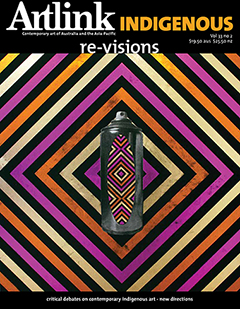The third annual issue series about developments in Aboriginal and Torres Strait contemporary arts is now available. Artlink Indigenous: re-visions focuses on the criticism of Aboriginal art, its history, its controversies, its place in Australian art. The issue also includes profiles of new and old artists as: Reko Rennie, Ken Thaiday Snr, Jimmy Pike, Bluey Roberts, Ryan Presley, Badger Bates, Julie Gough, and extended obituaries of six major artists. Writers include Vernon Ah Kee, John Carty, Jirra Lulla Harvey, Djon Mundine, David Garneau, Judith Ryan, Maurice O’Riordan, Karen Dayman, BrianMartin, Sue Ryan, Justin Bishop, Antoanetta Ivanova, Will Stubbs, Tony Albert, Matt Poll, and Troy-Anthony Baylis.
Articles selected:
My Country: interview with Bruce McLean
Feature by Daniel Browning
A conversation between Artlink Indigenous co-editor Daniel Browning and Bruce McLean, the curator of My Country, I still Call Australia Home: Contemporary Art from Black Australia. On June 1, 2013, a major exhibition opens in Brisbane – the largest exhibition of contemporaryIndigenous art ever held at GOMA – the Gallery of modern art. In this interview Browning and McLean discusses how artists and works in the exhibition makes a statement about the place of the artist, in terms of their country and their place in contemporary society.
The (white) elephant in the room
Feature by Maurice O’Riordan
Does Aboriginal art exist in a critical vacuum? Editor, writer and long-term Aboriginal art watcher Maurice O’Riordan takes the elephant by the tusks and reviews criticism and commentary on Aboriginal art over the last twenty years or so. He finds quite a lot has been written yetconcludes that “any critical framework for Aboriginal art in Australia is seriously crippled (or overlooked), and mired in broader nationalist tensions.”
“A common complaint is that there’s not enough critical writing on Indigenous Australian art, due largely to an aesthetic and spiritual impasse, and to political correctness gone mad. I agree with this but only insomuch as there is not enough critical writing on the arts as a whole, in the context of dwindling of related newspaper columns and TV broadcast time and the preference for pithy profile and promotional pieces in the glossieralbeit more popular art mags. There is still a mass of critical writing going on though, in print and online and even just within Australia but this writing, largely manifest through niche publishing and academic agencies, does not generally reach a mass readership.
So in this specialised mass of art critical writing, and visual arts criticism in particular, is Indigenous Australian art overlooked? What sort of writing has it generated? And what limits might critical disengagement from it suggest in view of broader cultural and national politic?…”
The limits of criticism
Feature by John Carty
Anthropologist John Carty casts his eyes over the last ten years of writing on Desert art, mostly in newspapers, and finds many cliches and inconsistencies. He asks: “Where are the fine-grained localised art histories, the rich biographies of our most interesting and important individual artists? Where are their voices?” And replies: “They are still waiting in the Desert.”
We can all look at the stars
A tribute to the talented artist Gulumbu Yunupingu by Will Stubbs
For Gulumbu Yunupingu the stars lead us upwards through life towards the heavens. Her works as ceremonial poles and barks painting depict this universal journey and are exhibited in several museums collections in Australia and overseas.
This magazine includes major exhibitions on the Aboriginal international art scene of the year including:
– string theory: Focus on contemporary Australian art, 16 August – 27 October 2013, Museum of Contemporary Art (MCA) Australia, Sydney;
– My Country, I Still Call Australia Home: Contemporary Art from Black Australia, 1 June – 7 October 2013, Gallery Of Modern Art (GOMA), Brisbane;
– Gestuelles – the art of transmission by Aboriginal Dessert Women, 16 April – 17 May 2013, Alliance Francaise de Melbourne.
